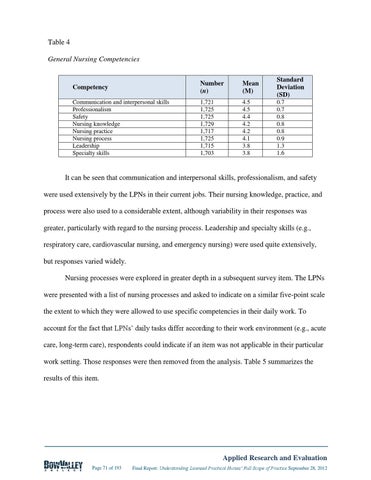Table 4 General Nursing Competencies
Competency
Number (n)
Mean (M)
Standard Deviation (SD)
Communication and interpersonal skills Professionalism Safety Nursing knowledge Nursing practice Nursing process Leadership Specialty skills
1,721 1,725 1,725 1,729 1,717 1,725 1,715 1,703
4.5 4.5 4.4 4.2 4.2 4.1 3.8 3.8
0.7 0.7 0.8 0.8 0.8 0.9 1.3 1.6
It can be seen that communication and interpersonal skills, professionalism, and safety were used extensively by the LPNs in their current jobs. Their nursing knowledge, practice, and process were also used to a considerable extent, although variability in their responses was greater, particularly with regard to the nursing process. Leadership and specialty skills (e.g., respiratory care, cardiovascular nursing, and emergency nursing) were used quite extensively, but responses varied widely. Nursing processes were explored in greater depth in a subsequent survey item. The LPNs were presented with a list of nursing processes and asked to indicate on a similar five-point scale the extent to which they were allowed to use specific competencies in their daily work. To account for the fact that LPNs’ daily tasks differ according to their work environment (e.g., acute care, long-term care), respondents could indicate if an item was not applicable in their particular work setting. Those responses were then removed from the analysis. Table 5 summarizes the results of this item.
Applied Research and Evaluation Page 71 of 193
Final Report: Understanding Licensed Practical Nurses’ Full Scope of Practice September 28, 2012
